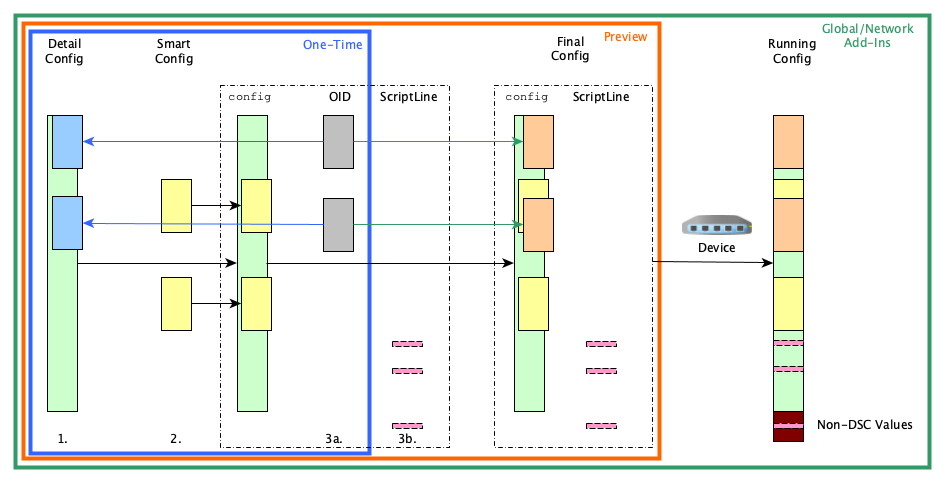...
| Deutsch | |||||||||||||||||||||||||||||||||||||||||
|---|---|---|---|---|---|---|---|---|---|---|---|---|---|---|---|---|---|---|---|---|---|---|---|---|---|---|---|---|---|---|---|---|---|---|---|---|---|---|---|---|---|
Um zu verstehen, wie die LMC Add-Ins funktionieren, müssen wir uns ansehen, welche Elemente auf die Konfiguration eines Geräts angewendet werden. Im Folgenden wird der Prozess beschrieben, in dem die Konfiguration verändert werden kann:
Das Ergebnis von 1-4 wird als Konfigurationsdaten an das Gerät gesendet. Die Skripte aus Schritt 4. werden auf dem Gerät ausgeführt, nachdem die Konfigurationsdaten übernommen wurden. Wie oben gezeigt, gibt es zwei Möglichkeiten, die Konfiguration eines Geräts mit Add-ins zu manipulieren.
* gerätespezifische Terminalsyntax Object Id (Oid)Jeder Konfigurationswert bzw. jede Tabelle wird durch eine maschinenlesbare Object Id, kurz oid, angegeben. Die oid ist eine Folge von Zahlen, die durch Punkte getrennt sind (das folgende Beispiel bezeichnet die LCOS-Cron-Tabelle):
Um die Konfigurationsdaten zu ändern, können Sie entweder einzelne Werte (Skalare) oder Tabellen/Zeilen abrufen/einstellen. SkalenSkalen sind Einzelwerte in der Konfiguration.
TabellenTabellen können eine feste oder eine dynamische Anzahl von Zeilen haben.
Skript-ZeileUm ein Skript auf dem Gerät auszuführen, nachdem die Konfiguration angewendet wurde, müssen Sie die Syntax
Das Skript-Zeilen-Beispiel setzt den selben Wert wie das Skalen-Beispiel oben. Die erste Zahl wird weg gelassen, ebenso wie das ., das in / übersetzt wird. Im Gegensatz zum Setzen von Werten über oid, können wir auch die menschenlesbare Notation verwenden, z.B. |
| Englisch | |||||||||||||||||||||||||||||||||||||||||
|---|---|---|---|---|---|---|---|---|---|---|---|---|---|---|---|---|---|---|---|---|---|---|---|---|---|---|---|---|---|---|---|---|---|---|---|---|---|---|---|---|---|
To understand of how LMC Add-ins work, we need to consider which elements are applied to the configuration of a device. The following is the process in which the configuration can be modified:
The result of steps 1 and 2 is sent as configuration data to the device. As shown above, we have two ways of manipulating the configuration of a device with Add-ins.
* device specific terminal syntax Object Id (Oid)Each configuration value or table is specified by a machine readable Object Id, short oid.
To modify the configuration data you can either get/set single values (scalars) or tables/rows. ScalarsScalars are single values in the configuration.
TablesTables can have a fixed or a dynamic number of rows.
Script-LineTo execute a script on the device after applying the configuration you need to use the
The scriptline example sets the same value as the scalar example above. The first number is ommitted as well as the In contrast to setting of values via oid, we can also use the human readable notation, e.g. |
...
